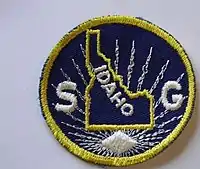Idaho State Guard
The Idaho State Guard, formerly known as the Idaho Home Guard, or The Idaho Volunteer Reserve (IVR) is the inactive state defense force of Idaho. The Idaho State Guard was created to replace the Idaho National Guard as a stateside homeland security force while the National Guard was in federal service. Their mission was to provide emergency services, including search and rescue missions and guard vital state infrastructure.
| Idaho State Guard | |
|---|---|
 Idaho State Guard insignia. | |
| Active | 1917–1946 |
| Country | |
| Allegiance | |
| Branch | Army National Guard |
| Type | |
| Role | Auxiliaries |
| Size | 8,502 (approximately) |
| Garrison/HQ | Boise, ID |
| Motto(s) | Pro Deo Domo Patria |
| Colors | Blue and Gold |
| Commanders | |
| State Military Leadership | Major General Mervin Gilbert McConnel Adjutant General of Idaho during World War II Idaho Governor Chase A. Clark Commander and Chief of the Idaho State Guard during World War II |
World War I
During World War I, the governor Moses Alexander ordered formation of four companies of Home Guard, with 100 men per company, paid for by the state.[1]
World War II
The Idaho Volunteer Reserve also known as the Idaho State Guard was formed 4 months after Japan's attack on Pearl Harbor. The IVR was formed by Governor Chase Clark in April 1942. The ADA County battalion was commanded by Col. Ralph Breshears. By July, Col Breashears reported the Ada Co. IVR strength was 1085 enlisted and 85 officers in 29 companies and by Dec. the Ada Co. IVR had 30 companies and the Canyon Co. IVR had 14 companies. At its peak, the IVR had 8,502 men in 165 companies throughout Idaho. Members of the Volunteer Reserve furnished their own weapons, ammunition and equipment, they wore unit insignia and carried certificates of enrollment. By April 1944, the threat of invasion of Idaho became virtually nonexistent and officials took steps to muster out all units of the Idaho Volunteer Reserve.[2] The State Guard of World War II was armed with Enfield rifles.[3] In September 1942, the Idaho State Guard became the first state military organization in the United States to induct women into its command structure when Governor Chase A. Clark administered the oath of enlistment to a group of women from the Idaho volunteer auxiliary reserves.[4] As of August 1946, after the war's conclusion, the Idaho State Guard remained in active service and was subject to call-up.[5]
Legal Status
The legal authority of each state to maintain its own state defense force is recognized by the federal government of the United States under Title 32, Section 109 of the United States Code.[6] Some twenty-three states and the Commonwealth of Puerto Rico actively maintain state defense forces.[7] Under Idaho law, the Governor of Idaho has the legal authority to activate the state defense force.[8]
See also
References
- Tulenko, Thomas; Chase, Bradley; Dupuy, Trevor N.; Hayes, Grace P. (March 1981). "US Home Defense Force Study" (PDF). StateDefenseForce.com. Historical Evaluation and Research Organization. Retrieved 9 December 2015.
- "Idaho "Home Guard" Organization to Start". Post Register. Idaho Falls, Idaho. Retrieved 9 January 2016.
- Lemon, John J. (19 December 1967). "Questions of Need, Cost Rise on State Riot Force". Spokane Daily Chronicle. Retrieved 9 January 2016.
- "Idaho State Guard Auxiliary Members Sworn In by Governor". The Spokesman-Review. Spokane, Washington. 28 September 1942. Retrieved 9 January 2016.
- "Help Needed In Idaho Fire". The Register-Guard. Eugene, Oregon. 20 August 1946. Retrieved 9 January 2016.
- "32 U.S. Code § 109 - Maintenance of other troops". Legal Information Institute. Cornell University Law School. Retrieved 9 January 2016.
- Carafano, James Jay; Brinkerhoff, John R. (October 5, 2005). "Katrina's Forgotten Responders: State Defense Forces Play a Vital Role". www.heritage.org. Retrieved 9 January 2016.
- "46-103. State Militia -- Division Into Classes". Idaho Legislature. Archived from the original on 5 March 2016. Retrieved 9 January 2016.